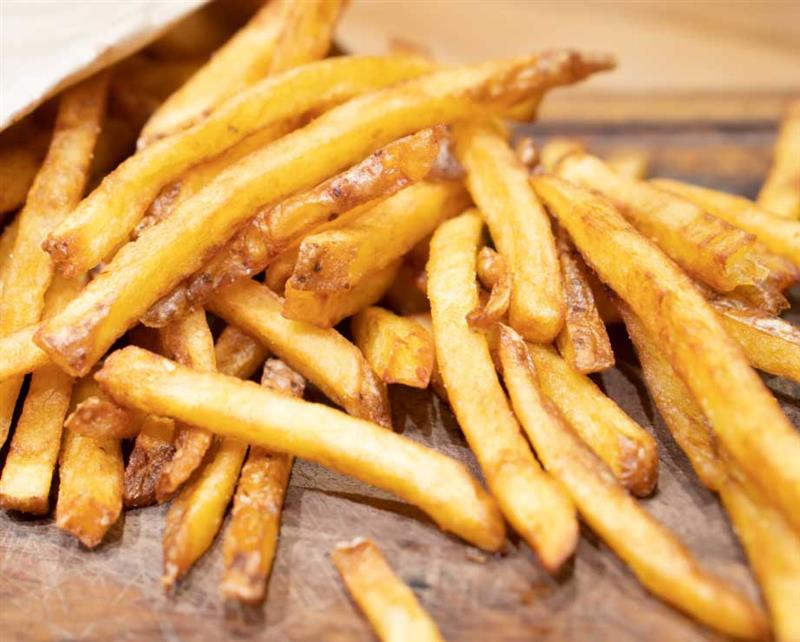Skin-on fries are more than just a rustic menu option; they’re a smart, flavour-packed and increasingly popular choice for modern food service operators. Whether you run a fast-food shop, takeaway or restaurant, skin-on fries deliver strong margins, sustainability advantages and broad customer appeal.
Here are the key benefits of adding (or highlighting) skin-on fries to your menu.
1. Natural, Rustic Look That Customers Love
Skin-on fries offer a sought-after, authentic look in a world of polished presentation and social media food photography. They feel less processed, more ‘hand-cut’ and closer to home-cooked, which is exactly what many customers now expect.
Tip: Highlight ‘skin-on’ on your menu description. The name alone signals a more premium, natural option.
2. Better Flavour and Texture
The potato skin adds depth of flavour and a slightly crispier texture after frying or baking. Many chefs and customers report that skin-on fries retain more of the potato’s earthy, savoury notes, especially when seasoned with paprika, rosemary salt or garlic.
3. Higher Fibre and Nutrient Content
Leaving the skin on helps preserve fibre, potassium and vitamin C that would otherwise be lost in peeling. Whilst fries aren’t typically marketed for health benefits, skin-on options can offer a nutritional edge, especially in school and health-conscious settings.
Note: This can also be a talking point for allergen-conscious or whole food-focused menus.
4. Reduced Food Waste = Greater Sustainability
Skin-on fries contribute to more sustainable kitchen practices by using the whole potato. Reducing peel waste not only supports eco-friendly goals but also lowers prep time and disposal costs in fresh prep environments.
Perfect for: Restaurants, takeaways and caterers looking to meet ESG or sustainability targets.
5. Ideal for Loaded and Dirty Fries
Skin-on fries are firmer and hold their shape better under heavy toppings, sauces and reheating. That makes them perfect for loaded fries, a high-margin, high-demand menu category.
Pair them with:
- Halal chicken, vegan chilli or falafel.
- Garlic mayo, BBQ, chipotle or curry sauce.
- Cheese, onions, jalapeños and fresh herbs.
6. Great for Takeaway and Delivery
Skin-on fries tend to stay crisp longer in transit compared to thinner, peeled fries. The skin acts as a natural barrier to moisture, helping maintain that all-important crunch.
Tip: Pair with vented, compostable packaging to maximise texture and eco-appeal for delivery customers.
7. Strong Margin and Upsell Potential
The visual appeal and ‘premium’ perception of skin-on fries means you can often charge more, whether sold as an upgrade, part of a gourmet burger meal or as loaded fries.
Example menu copy:
“Swap to skin-on rosemary fries for just 50p more”
8. Versatile in Cuts and Formats
Skin-on fries are available in:
- Thin cut (7mm to 10mm)
- Steak cut or chunky
- Wedges and crinkle cut
- Sweet potato skin-on fries
This makes them a fit for everything from quick fry snack bars to plated gastro mains.
9. Aligns with Natural and Clean Label Trends
Today’s consumers want transparency and authenticity. Skin-on fries have a more natural appearance and simpler ingredients, as well as fewer additives and coatings, which can align better with a ‘clean label’ or free-from dining priorities.
10. Reduced Prep and Labour (When Frozen)
Frozen skin-on fries eliminate the time and mess of peeling and prepping fresh potatoes without losing quality. They’re fast to cook, easy to portion and consistent in performance, making them a smart choice for fast-paced kitchens.
Ready to Try Skin-On Fries?
From fast casual operators to school catering teams, skin-on fries offer a flexible, flavour-forward solution. Magna Foodservice stocks a full range of frozen skin-on options to suit menu style and service needs.
A Brief History of Skin-On Fries
The exact origin of French fries is debated, with both France and Belgium claiming to be their birthplace. Regardless of their origin, the practice of leaving the skin on fries has gained popularity in recent years. This approach aligns with a growing preference for rustic, less processed foods that emphasise natural flavours and textures.
Sustainability Benefits
Leaving the skin on potatoes reduces food waste and supports sustainable kitchen practices. According to the U.S. Environmental Protection Agency, food waste constitutes a significant portion of municipal solid waste, contributing to greenhouse gas emissions. By utilising the entire potato, skin-on fries help minimise waste and promote environmental responsibility.
Nutritional Advantages
Potato skins are rich in nutrients, including fibre, potassium, vitamin C and antioxidants. Retaining the skin enhances the nutritional profile of fries, offering a healthier alternative to traditional peeled versions. As noted by Chowhound, “Potato skins are high in fibre and are packed with loads of potassium, vitamin C, and antioxidants.”
Flavour and Texture
Skin-on fries provide a deeper, earthier flavour and a satisfying crunch. The skin adds a layer of texture that enhances the overall eating experience. This rustic appeal resonates with consumers seeking authentic and hearty food options.
Operational Efficiency
For foodservice providers, skin-on fries offer practical benefits. They require less preparation time, as there’s no need to peel the potatoes (if necessary), and they often have a longer shelf life. Additionally, their robust texture makes them ideal for loaded fry dishes, as they hold up well under various toppings and sauces.
Consumer Appeal
The trend toward natural and minimally processed foods has increased the popularity of skin-on fries. Their wholesome image and enhanced flavour profile make them a favourite amongst health-conscious consumers and food enthusiasts alike.
Skin-on fries represent a fusion of taste, nutrition and sustainability. By embracing this approach, food operators can offer a product that satisfies consumer demand for flavourful, wholesome and environmentally responsible food options.

